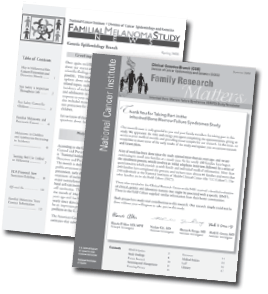
- Linkage Home
- DCEG Holds Annual Retreat
- DCEG Welcomes Visiting Scholar Paul Pharoah
- Christian Abnet: Seeking to Understand Cancer Risk
- Spring 2008 Intramural Research Award Winners
- Kai Yu Loves to Solve Problems
- NIH Recognizes 2009 FARE Winners
- Inaugural Meeting of THYGENE Consortium
- Monograph on Familial Cancer Syndromes Published
- An Update on the InterLymph Consortium
- 2008 DCEG Summer Fellows
- Koutros Wins Student Prize
- Consortium Will Focus on Esophageal Disease in Asia
- Recent Newsletters on Familial Cancer Research
- Zahm Receives Harvard School of Public Health Alumni Award of Merit
- DCEG Staff Win NIH Merit Awards
- Investigators Newly Awarded Tenure
- Committee of Scientists Update
- Power Calculator for Genetic Association Studies
- Scientific Highlights
- DCEG Staff Win NIH Director's Awards
- Internet2 IDEA Award
- DCEG People in the News
- Comings...Goings
- Sharon Miller Retires
- DCEG Staff at Work and Play
Recent Newsletters on Familial Cancer Research
Families that share genetic mutations, particularly those that may lead to cancer, make important contributions to our knowledge of cancer when they participate in clinical trials. The Genetic Epidemiology Branch (GEB) and Clinical Genetics Branch (CGB) regularly prepare newsletters to inform study participants of research progress and related information.
GEB, which has been studying families with multiple cases of cutaneous melanoma for more than three decades, recently mailed a new edition of the Familial Melanoma Study Newsletter to approximately 2,000 study participants. The newsletter focused on the importance of lifelong sun safety, highlighting exposure to ultraviolet light as the primary modifiable risk factor for melanoma and non-melanoma skin cancers.
The newsletter summarized an article reporting an excess of pancreatic cancer observed among a subset of the study families, some of whom have mutations in CDKN2A, a documented melanoma susceptibility gene. However, there are no recognized genetic or other factors that identify which, if any, family members may be at increased risk of developing pancreatic cancer. Branch investigators are actively working on answering this question. Resources for further information about pancreatic cancer were also included.
Other articles included a consensus report by the International Agency for Research on Cancer on its recent review showing that tanning bed use during the teenage years and twenties is associated with an increased risk of melanoma and squamous cell skin cancer; an article on the FDA’s proposed new sunscreen labeling regulations; and a discussion of the increasing incidence of melanoma among adolescents and young adults observed in the NCI Surveillance, Epidemiology, and End Results (SEER) database.

In addition, CGB recently published the first issue of its newsletter for participants in the Inherited Bone Marrow Failure Syndromes (IBMFS) Study, summarizing activities since the study opened in January 2002. The newsletter outlined the clinical, laboratory, and genetic information and the risks of malignancies (leukemia and solid tumors) for each of the component disorders in IBMFS: Fanconi anemia, dyskeratosis congenita (DC), Diamond-Blackfan anemia, Shwachman-Diamond syndrome, severe congenital neutropenia, amegakaryocytic thrombocytopenia, and thrombocytopenia with absent radii.
Major findings from IBMFS related to DC were also highlighted in the newsletter. DCEG researchers were the first to show that patients with DC could be identified by abnormally short telomeres in white blood cell subsets, an innovation that led to reclassification of several patients with aplastic anemia who were initially thought to have an acquired, not genetic, disease. Adding telomere length to the case definition for an NCI genetic linkage study resulted in the discovery of a new gene for the syndrome, TINF2. Mutations are more common in this gene than in any genes previously found to be associated with DC.
The newsletter included general and syndrome-specific recommendations for screening and management of these rare disorders as well as an extensive glossary of relevant medical terminology. It was mailed to nearly 700 study participants ages 18 and older, pediatric hematology/oncology specialists, and genetic counselors who focus on oncology and prenatal genetics.
—Mary C. Fraser, R.N., M.A., and Blanche P. Alter, M.D., M.P.H.
